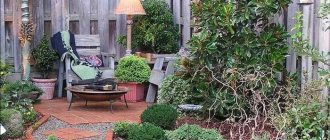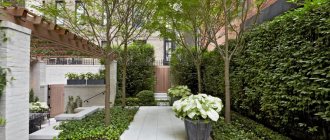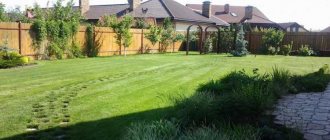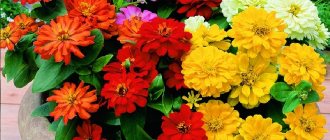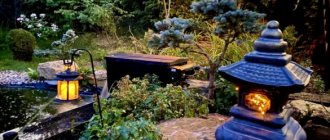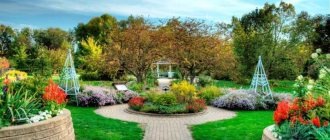If your garden has a high groundwater level, and during spring floods and after heavy rains the water stagnates in some places for a long time, plant plants that are suitable for such conditions.
It often happens that during snow melting or after heavy rainfall, groundwater in the area remains at a high level for a long time. In such a situation, the roots of trees and bushes remain in the water for a long time, cannot breathe, and after a while they die.
The opposite situation is also common, when the soil on the site is damp and wet, but the plants nevertheless dry out and also die. This phenomenon is called physiological drought, which is caused by a lack of air reaching the plant roots. If the groundwater level is high (about 0.5 m), and the soil is dense and does not absorb water well, which is why it is almost impossible to drain, the choice of plants should be treated with special care.
Unfortunately, it is impossible to change the hydrological features of the area; you can only adapt to existing conditions. Therefore, it is necessary to plant plants that can tolerate excessive soil moisture. In areas with damp soil, trees and coniferous shrubs grow poorly. However, there are exceptions among them: these are little popular, but worthy of attention, ornamental plants that will decorate your garden even though it is difficult to get through in the spring because of the water.
How to determine the need for dehumidification
The owner of the site, who has owned it for a long time, knows the problem of the site without conducting an examination or geological survey - he observes flooding with sedimentary waters every time the snow melts or the rainy season begins. This happens when the soil is clayey and poorly allows water to penetrate deep into it, or the groundwater lies high and high water is added to it.
Another reason is that the site lies in a lowland and water flows from the neighboring slopes, but does not always quickly seep deeper. The proximity of a pond or swamp also has an effect.
If the plot has just been acquired, then you can only find out about the dangerous proximity to the groundwater surface in spring or autumn. But you can see the manifestations of swampiness in the area as follows:
- swollen and warped door frames;
- cracks are noticeable on the walls and corners;
- there is a smell of dampness in the rooms and premises;
- outside (on the north side or in the shade) there is mold on the base;
- the basement is damp or there is water in it;
- There are a lot of mosquitoes in the evening.
Why do you need an oak tree?
Let's start with a classic case. Moscow once suffered from floods every year. It was decided to plant an array of spruce forests in the areas west of the city, where the watershed sources are located. The trees took ten years to plant.
As a result, the floods decreased significantly - the spruce forest retained a significant amount of water.
TOOLS FOR HOME AND GARDEN, HANDCRAFTS, ETC. PRICES VERY LOW
Yes, you can make your plot drier by planting hygrophyte trees that prefer highly moist soils. It is advisable to place spruce, floodplain oak along the perimeter of the site, and willow along the perimeter of the drainage channels. And they will suck water from the nearest territory around the clock.
Drying methods
When purchasing a new property, the problem with excess moisture is often discovered after the deal is closed. And it must be resolved as soon as possible, before the start of construction or reconstruction of existing buildings. The first option is, of course, preferable, because it gives more opportunities - for example, to arrange wall drainage when laying the foundation or to create a comprehensive drainage system using several methods. And there are not so few such options.
The following main methods of combating site flooding can be listed:
- Surface or open drainage.
- Deep or closed drainage.
- Cut-off drainage.
- Vertical drainage.
- Backfilling the area (raising the level).
- Planting moisture-loving plants.
A related, but no less important, system is storm sewerage. It is often combined with one of the types of drainage. But this is not an axiom - stormwater can exist in parallel so as not to increase the load on the groundwater drainage system.
The lack of a full-fledged storm drainage system, a large roof area, waterproof coverings of platforms and paths, massive buried foundations of buildings and fences - all this can disrupt the water balance, worsen the natural drainage of water and lead to waterlogging of an initially healthy area.
Advice from experienced gardeners
Some summer residents recommend planting the tree in a planting hole, where a piece of plastic is placed at the bottom of the earthen depression. This should stop the root system from growing downward and allow it to grow outward.
It is also recommended to make a wooden box. To do this, you need to put together a wooden box, 2x2 meters in size and 1 m high. Fill the box so that the boards are covered with soil. To support the hill, boards are left.
Interesting! Some gardeners recommend being more careful when choosing seedlings, since in practice some plants take root better in such soil.
Drainage, as a rule, is an expensive measure; for this reason, gardeners still recommend the use of artificial embankments, this way you can raise the level of part of the site by a meter (depending on what trees are planted, the type of root system and the sensitivity of the plant to moisture).
It is possible to grow trees and shrubs on dwarf rootstocks. In order to limit the growth of the root system, grafting onto waterproof rootstocks of other species is required (apple or pear is grafted onto rowan, cherry onto sloe). Downward root growth can be limited. To do this, an impenetrable barrier (slate sheet) is created, or the tap root is trimmed.
- Author: Maria Sukhorukikh
Rate this article:
- 5
- 4
- 3
- 2
- 1
(0 votes, average: 0 out of 5)
Share with your friends!
Drying with drainage
It is the drainage of the site that most radically solves the problem of drainage of sedimentary and groundwater, and backfilling the site and planting moisture-loving plants only increases the efficiency of the system by reducing the load on it. The design of any type of drainage system consists of creating surface or deep channels that collect water and drain it into a drainage well or outside the site (ravine, pond).
Open systems
This is the main competitor of deep drainage. A distinctive feature of the system is that water is drained from the site through a network of open channels of various shapes and depths, located at a slope towards the drainage. This is a relatively simple drainage method that requires minimal excavation work. And in this case, the excavated soil will not be lost, but can be used for backfilling, leveling the terrain and raising the soil level.
What trees to plant near a cesspool in order to forget about pumping it out for a long time
As a rule, the greatest load on the cesspool of a private house occurs in early spring, during the period of active snow melting. The groundwater level rises in the area, and so-called “overwater” appears, which can penetrate into your leaky cesspool through the top or walls. The water level in it will rise.
Flooded house and plot as a result of spring snow melting.
During this period, there are no leaves on the trees yet and sap flow is just beginning. However, there are still trees that will help us at this time of year - these are conifers:
Spruce
Spruce is the decoration of the site.
Unlike, for example, pine, spruce absorbs and evaporates much more moisture - an adult tree up to 300 liters per day (pine up to 150) and looks very aesthetically pleasing on the site. In addition to the fact that the spruce will look very harmonious, it can be dressed up for the New Year, and in the spring it will help you cope with the abundance of water on the site.
Thuja
Thujas can be planted on the site either as a hedge or in separate compositions.
The roots of a large adult thuja go about 2 meters deep into the soil, and it is capable of evaporating up to 50 liters of water per day. If you plant several or a whole row of thujas around the perimeter of the cesspool, they are able to evaporate a significant amount of moisture in the planting area. In addition, they will look very beautiful on the site and will not require watering on hot summer days.
Pine
Pine trees on the site are always beautiful.
A large spreading pine tree can take up to 150 liters of water per day from the soil. There are many decorative types: black, Scottish, Weymouth pine, which, when properly formed, look very harmonious on a personal plot. If you are a “fan” of conifers with large needles, this is your option. Again, the pine tree can be decorated during the New Year holidays by hanging garlands on it. This tree can become a real decoration of your site.
Other conifers
Other tall coniferous trees - firs, cedars, junipers and others can also be planted near a cesspool or septic tank. When planting, pay attention to the characteristics of a particular plant and the climate zone in which you live.
Construction of artificial reservoirs
If the size and geological features of the site allow, then one of the ways to drain the site can be considered the creation of an artificial pond. This can be done when the lowest and wettest place is located on the periphery of the site. And although this method is called drainage without drainage, surface drains here can be present in the form of ditches designed as decorative or “dry” streams.
Birch
An ideal option for drying damp areas is to plant several birch trees at the dacha. A mini-alley in the lower part of the site will remove all unnecessary moisture from the soil.
The most suitable species for this purpose is downy birch. It can withstand low temperatures without problems, so the tree can be planted even in northern regions.
One birch tree can “drink” up to 200 liters of water per day. When planting, make a hole 1 m in diameter. Stones of different sizes are thrown to the bottom, but in no case a brick. This drainage will help the roots quickly establish themselves in the soil. The layer will be about 50 cm thick, so the recess should be more than a meter.
Planting moisture-loving plants
Another option for drying without drainage is to plant moisture-loving plants that “work” as a natural pump with an evaporator function. The root system of such plants actively absorbs water, and the abundant leaf cover evaporates moisture. Of course, the productivity of this drainage method is not high, but in combination with traditional drainage systems it has a positive effect.
As an independent method, this approach is justified only under conditions of slight swampiness or as a preventive measure. For example, in summer cottages with non-permanent residence, when there is no urgent need to remove melt or sediment water. By using trees, shrubs and grasses that absorb a lot of water, you can reduce flooding due to high water and speed up the drying of the top layer of soil after spring floods or autumn rains. Moisture-loving trees include all species that grow in nature near rivers, lakes and wetlands: willow, alder, birch. Along the perimeter, as a hedge, you can plant shrubs: rose hips, hawthorn, viburnum.
Deciduous trees for wet soils
Among deciduous trees there are many more plants that calmly “treat” too wet soil.
Gray alder
One of the most “patient” in this sense is gray alder (Alnus incana). The gray alder Pendula (Pendula) - an original tree reaching 6 m in height and width - tolerates wet (swampy, coastal) soil quite well. Its shoots flowing down to the water on the shore of the pond look very romantic. But this tree is still large; smaller forms are suitable for growing in front gardens. Bush varieties of alder amaze with their unusual colors, for example, alder Aurea with golden leaves. The tree of the Laciniata variety looks unusual, with an openwork crown and dissected leaves atypical for the crop.
Gray Alder Laciniata
White willow
Wet areas are a favorite habitat for various species of willows. The most popular is white willow (Salix alba). Its garden form, known from parks and city squares, is Tristis - a weeping willow with hanging shoots. Many unusual varieties have also been bred - with silver leaves - Sericea and with bright red or orange ascending shoots - Chermesina.
White willow Chermezina
It should, however, be remembered that you need to choose a willow so that the parameters of an adult tree correspond to the size of the garden. The classic willow Tristis is a tree for large spaces, fast growing and expansive. In small gardens, it is more logical to plant purple willow Nana or Pendula.
Pterocaria (ash-leaved lapina)
Blooming pterocaria resembles a green waterfall
A lesser-known tree is the ash-leaf lapina, or pterocarya (Pterocarya fraxinifolia). It grows well in flooded lowlands and can withstand prolonged stagnation of moisture, so it is recommended for planting along the banks of reservoirs, in damp places that are not suitable for other plants. Large feathery leaves and hanging inflorescences-catkins give the plant a special charm.
Kaluzhnitsa
Marigold is also known by the names "water snake" and "paddling pool", which reflects the penchant of this beautifully flowering perennial plant for damp, marshy areas. Dense, almost round leaves with a diameter of up to 12 centimeters grow on the branched stems of this crop. Attractive golden inflorescences that bloom in April-May give the plant a special charm. Marigold is used to create a spot of color in the foreground of the garden, to decorate a wet flower bed. The most popular among gardeners are the horned marigold, the multi-petalled marigold with golden flowers, and the marsh marigold.
In case of excessive growth, division of marigold is carried out every 3-4 years. This crop needs a lot of sun, but it can do with partial shade under trees with a not too dense crown.
Swamp spurge
The Euphorbiaceae family includes herbaceous plants, subshrubs, shrubs and trees. Swamp spurge stands out among them for its love of dampness. Under natural conditions, it grows in water meadows; in the garden it can tolerate short-term flooding. In landscape design, this crop is used to form a background for other plantings, create a textural accent, and is used to decorate ponds and decorate wet flower beds.
This perennial plant with a large cylindrical rhizome is characterized by unpretentiousness, but at the same time it is aggressive and toxic. Bare bluish shoots are decorated with narrow bright foliage. The inflorescences located on top have an inconspicuous appearance. After flowering is completed, pruning is performed to thicken the clumps. Once every 3-4 years, swamp spurge is rejuvenated by completely removing the above-ground part. For normal development of this crop, moist soil and a lot of light are required. For tall varieties you need to install supports.
Thyroid darmera
Thyroid darmera is a herbaceous perennial plant with huge leaves. It tolerates cold well in winter. Darmera does not shoot underground shoots; the bush grows evenly. The knobby, powerful, thick rhizome of the plant has a diameter of 6 centimeters.
With the help of this crop, the coasts of reservoirs and large wetlands are decorated; it is used for arranging damp flower beds. Green leaves with veins and grooves are perfect for this purpose. Throughout the season, streaks and purple spots appear on them. Flowering occurs in April-May, before the leaves appear. The beauty of delicate pink flowers is emphasized by unusual purple stems. The best soil for dharmera is one with variable levels of swampiness. She doesn't really like sunlight and prefers partial shade. If the bush grows excessively, it is divided. It is recommended to trim the flower stalks. Fertilizing is done every spring. The most common variety “Nanum” has a height of up to 50 centimeters.
What to plant in a wet place?
What grows in wet places
- Iris and aquilegia love dampness
- Swamp iris
- Lilylily
- Aquilegia
- Phlox spotted
- Difficult task
- Garden on the swamp
- CONSULTATION WITH A SPECIALIST
Interesting materials:
Where is the best place to plant lupine? Where is the best place to plant onions before winter? Where is the best place to plant magnolia? Where is the best place to plant Weeping Willow? Where is the best place to plant climbing roses? Where is the best place to plant purslane? Where is the best place to plant radishes? Where is the best place to plant a columbine? Where is it better to plant honeysuckle in the shade or in the sun? Where is the best place to plant garlic?

